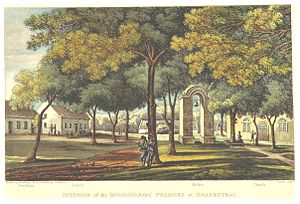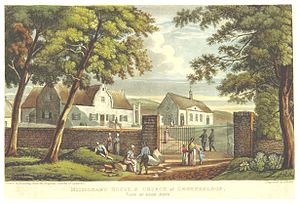Genadendal
| Genadendal | ||
|---|---|---|
|
|
||
| Coordinates | 34 ° 3 ′ S , 19 ° 34 ′ E | |
| Basic data | ||
| Country | South Africa | |
| Western cape | ||
| District | Overberg | |
| ISO 3166-2 | ZA toilet | |
| local community | Theewaterskloof | |
| Residents | 5663 (2011) | |
| founding | 1738 | |
|
Church of the Moravian Church
|
||
Genadendal is a place in the province of Western Cape in South Africa . In 2011 it had 5,663 inhabitants. It is located around 110 kilometers east of Cape Town in the Overberg district at the foot of the Riviersonderendberge with the peaks Uitkykkop (German: "Aussichtskopf", 1466 meters high) and the Jonaskop (German: "Jonaskopf", 1648 meters high). The world's largest number of naturally occurring sugar bushes (Protea) can be found at the Jonaskop .
history
Genadendal was the first mission station in southern Africa . The German missionary Georg Schmidt was sent to South Africa by the Moravian Brethren in 1737 to preach the Gospel to the Khoikhoi . Genadendal was founded in 1738 after Schmidt himself moved to the Baviaanskloof (German: "Paviansschlucht") on April 23, 1738.
Georg Schmidt arranged for the station to create gardens for its own supply. Their irrigation was done through canals with water from the nearby Sonderend River . Through these systems, the indigenous population in the Cape region came into contact with irrigated agriculture of the Europeans for the first time . The irrigation system continued to operate after 1744, but fell into disrepair years later.
Schmidt was expelled from the country in 1744, officially because the bell in Genadendal disrupted the community in Stellenbosch , 100 kilometers away , and Schmidt was not an ordained pastor. The real reason is that Schmidt had started to teach the natives who had settled in Genadendal and the slaves who had fled to read and write. This made them more educated than many farmers in the area.
In 1792 Schmidt's successors, the ordained pastors Marsveld, Schwinn and Kühnel, came to Genadendal. They also found the Khoikhoi woman Vehettge Tikkuie, called Moeder Lena, who was able to read from the Bible that Schmidt had left behind. During this time, the irrigation agriculture in the vicinity of the mission station began to be put back into operation with the participation of the Coloreds and Khoikhoi population. This form of agriculture gave the impetus for similar plants in the nearby valley of the Boesmanskloof River near Greyton .
In 1820 the second solid stone bridge was inaugurated in the Cape in Genadendal over the Sonderend River (German: "River without end") with the name Beinbrecht Bridge. Johann Daniel Beinbrecht was a pastor in Genadendal from 1815 to 1824 and worked as a coppersmith.
The first school was built in 1831 and the first school in South Africa for teachers and national assistants was founded in 1837. This building is now the Moravian Mission Museum . In 1883, three former students from the assistant school were ordained missionaries for the first time. In 1891 the first non-white teachers were hired at the assistant school itself.
In the printing works (Genadendalse Drukkery) established in 1859 , the first Afrikaans-language printed matter was produced in South Africa. The mixture of the Dutch dialect of the Boers and the languages of their slaves, also known as “Kitchen Dutch”, was a kind of lingua franca that masters and slaves used to communicate. From this came today's Afrikaans , the mother tongue of the descendants of both sides.
The Moravian Mission Museum is the only museum in South Africa whose contents have been declared a "National Treasure". In 1995 Nelson Mandela renamed the official residence of the South African President in Cape Town to Genadendal ( Genadendal Residence , previously Westbrook ). On October 10, 1995, he visited Genadendal.
Genadendal in literature
In 1966, Bernhard Krüger published his dissertation under the title The Pear Tree Blossoms, The History of the Moravian Church in South Africa 1737-1869 (Genadendal and its satellites, a history of the Moravian Mission stations at the Cape, 1737-1869) at the Rhodes University , where he describes the history of the Moravian Church in South Africa from 1737 to 1869.
literature
- Bernhard Krüger: The Pear Tree Blossoms, The History of the Moravian Church in South Africa 1737-1869. 1966
- Martina Horak-Werz: Fax to Cordula. Experience as a pastor in South Africa in a time of political upheaval. 2006, ISBN 3-939434-00-0
Web links
- Genadendal history, current location, historical town center
Individual evidence
- ↑ 2011 census , accessed November 18, 2013
- ↑ a b Traugott Molter: Water balance and irrigation agriculture in the Cape. Franz Steiner Verlag, Wiesbaden 1966, p. 143
- ↑ Nelson Mandela : Address by President Nelson Mandela to the Provincial Synod of the Moravian Church in South Africa, Port Elizabeth . on www.mandela.gov.za (english, afrikaans, isiXhosa)
- ↑ Dissertation.com: bibliographic evidence, PhD Divinity (English)
- ↑ HeBIS: bibliographic evidence 1
- ↑ BSZ: bibliographic evidence 2










